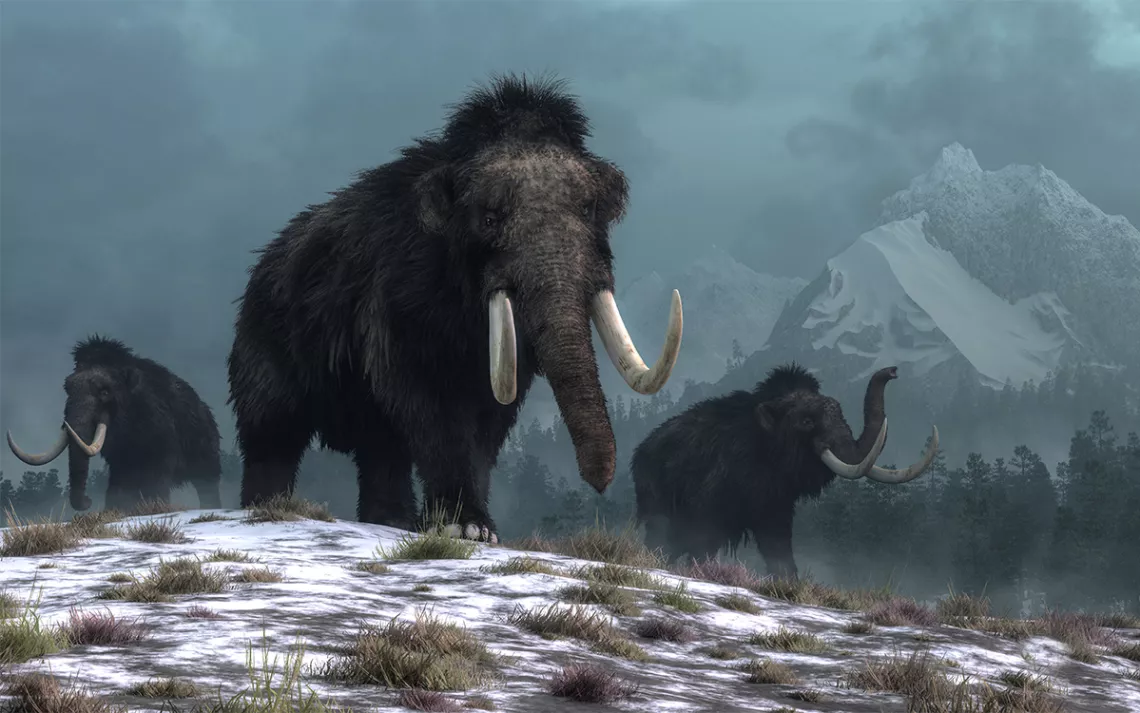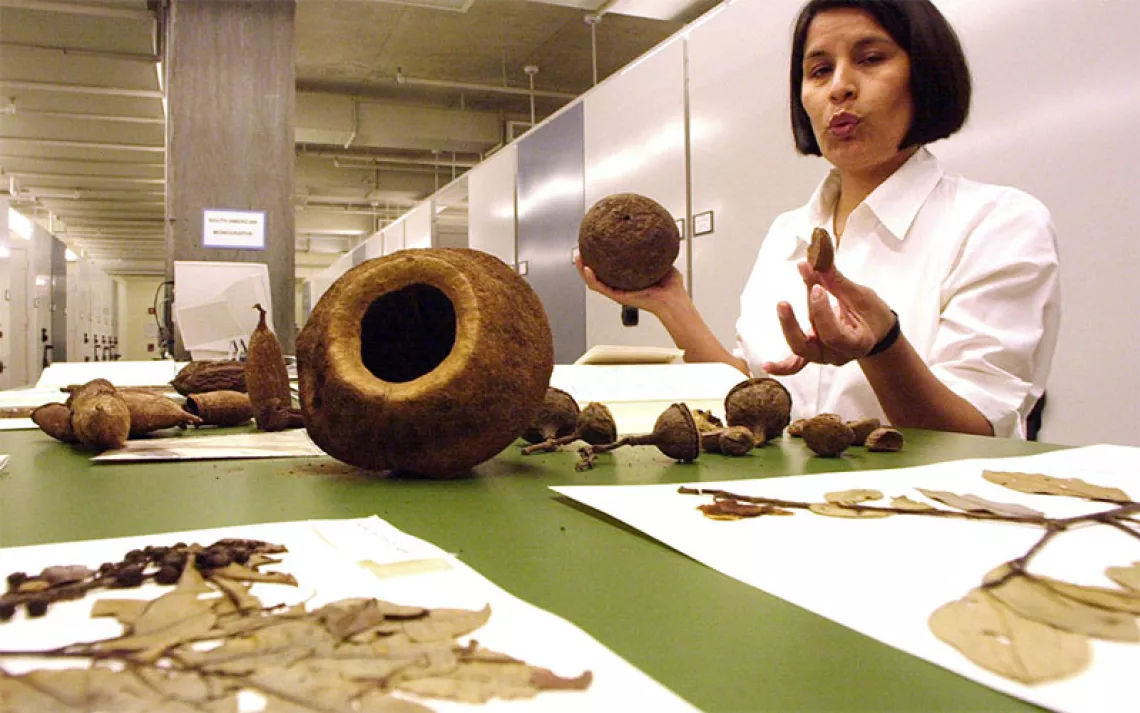The Asteroid and the Fern
A paleoecologist on what the past can teach us about climate change

A trio of woolly mammoths trudge over snow-covered hills. | Illustration by Daniel Eskridge/iStock
This essay is an excerpt from Not Too Late: Changing the Climate Story From Despair to Possibility, edited by Rebecca Solnit and Thelma Young Lutunatabua (Haymarket 2023).
In September 2018, I found myself in the vast expanse of the Siberian taiga. It was my first time north of the Arctic Circle, and I was traveling through time. We were chasing rumors of incredibly well-preserved ice age specimens—not the tiny pollen grains or dung fungus spores I usually work with in my forensic reconstructions of vanished landscapes. These were reported to be entire organisms, complete with skin and flesh and fur, perfectly preserved for tens of thousands of years by the permafrost. I’d spent more than a decade researching ice age ecosystems, but I had never actually seen one except in my mind’s eye, a mental tableau populated by long-dead species and a vanished climate. I had flown nearly around the globe to get as close as I could to the past, hoping that the mammoth-filled Pleistocene could reveal clues about our own warming world.
As I descended into the glittering darkness of a permafrost tunnel, I felt like Orpheus searching not for a lost lover but for a past that had always remained just outside my grasp. And I soon found it: frosted teeth and bones of mammoths, woolly rhinos, steppe bison, and horses, jutting from the frozen ripples of dark soil like chunks in a freezer-burned ice cream. The surface was dotted with clumps of ancient grasses, still green—and even entire trees in some places. I was walking through a nearly intact ecosystem, frozen in time. Some inhabitants, like the cave lion and the mammoth, had vanished forever. Others, like the caribou and the lark, had survived. What was the secret to their resilience? Were they just lucky spinners on fortune’s wheel? Or did they know something I didn’t about surviving an apocalypse?
I’ve held countless mammoth bones, teeth, and tusks. I’ve dedicated the better part of my career as a scientist to understanding the ecological consequences of climate change and extinction. But it wasn’t until my journey into the Siberian permafrost that the past became real to me. These weren’t specimens in a laboratory; they were individuals. They had hearts that beat like mine and lungs that expanded to resist death, even at the last. Among the remains of those doomed species gathered for millennia in the long dark, I mourned, but I also marveled at the incredible resilience of the survivors. And, as my breath frosted in the light of my headlamp, I promised to honor the dead by serving the living: the muskox and the rhinoceros and the larch trees who were their kin—and ours.
When I emerged from the permafrost tunnel, I knew I was not the same person who had entered. The proximity to past upheavals—so much death and data concentrated in one place—had changed me. And like Orpheus, I could not resist the urge to look back—not because of the ghosts I’d left behind in that glittering underworld, but because of what waited to greet me outside. It’s the present that has always called me back to the past; it’s the living who compel me to speak with the dead. As I climbed up and out, I stepped into the light of the same Arctic sun that had set on the last woolly mammoth some 3,700 years ago, even as it rose on my own ancestors, half a world away.
As a paleoecologist, my work takes me to some of the worst moments in Earth’s history, from apocalyptic asteroids to the climatic disruptions at the end of the last ice age. On a bad day, the fossil record reads like a casualty list five billion years long. We even divide the geologic timeline by the branches that drop off the tree of life, marking the moments when a particular group of organisms disappears from the fossil record forever. Indeed, the planet has hurtled from one catastrophe to another like a giant pinball, careening from icehouse to hothouse and back again: oceans starved for oxygen, great volcanic arcs spewing greenhouse gases, the deadly cloak of an impact winter, mass death.
Yet every time we roll toward oblivion, the flipper sends us back into the game, and the scoreboard dings and flashes as biodiversity ticks upward once again. In the aftermath of every catastrophe, the survivors radiate into a diversity of forms and strategies, weaving new patterns in the tapestry of life. It is a story as awe inspiring as it is sobering. The fossil record reveals just how far we can push an ecosystem before it collapses like a Jenga tower, or how suddenly an ice sheet or an ocean current can turn on a super-heated dime. The rocks compel us to remember, not only that we do not repeat the past but also that we understand what it took to build a present worth protecting.
The very worst mass extinction in Earth’s history took place at the end of the Permian, some 251.9 million years ago. It was so utterly world shattering that scientists call it the Great Dying: roughly 90 percent of life on Earth was lost—a literal decimation. Even the insects, which tend to emerge from mass extinctions relatively unscathed, were hit hard. The end-Permian extinction was caused by an enormous injection of atmospheric greenhouse gases by a group of volcanoes known as the Siberian Traps (ironically, not far from where I had my permafrost epiphanies). Their emissions caused the global oceans to acidify and temperatures on land to skyrocket by 10° to 30°C. Eons before cryptocurrencies or coal fired power plants, and long before our ancient ancestors unlocked the secrets of fire, climate change nearly ended our story before it had even started. It’s hard to conceptualize the scale of these losses and how profoundly they shaped the Earth, even on what feels like the cusp of our own apocalypse.
The past is not a perfect analog for the present, of course. The heat wave that triggered the Great Dying took around seven hundred thousand years to unfold, and ours has barely spanned the breadth of a human life (though we’re fortunately not anywhere close in terms of the magnitude of warming of the end-Permian). If you’re not an aficionado of deep time, it might as well have unfolded in a galaxy far, far away, this momentous turning point in the history of life buried in the layers of a past so distant we struggle to comprehend it. The story lies deep beneath our feet and far beyond the reaches of memory. But for those who can speak the language of fossils and sediments, the past is not just an object lesson; the Earth has left us a road map for how to survive the climate crisis.
For those of us born into individualistic cultures, the vastness of deep time can be just as terrifying as it is comforting; it provokes our deep-seated fear that we are insignificant and powerless, even as it assures us in our darkest moments that things will not always be as they are now. But just as an ocean is a multitude of drops, eternity is an amalgam of moments: the minutes, hours, and days in which we find ourselves bound together, and to the planet, with a charge to be good ancestors. In five billion years—nearly as long as the Earth has existed—our sun will explode, regardless of whether we are very good or very bad at tending to the planets it illuminates. This fact does not lessen our responsibility to fill that time with as much regard for life as we can, in the liminal space between Earth’s creation and destruction. We have always known this, deep down; why else would we plant trees that we know will never shade us?
The great irony of the fossil record is that we wouldn’t be here without extinction. Had the dinosaurs not died out, there would have been no age of mammals and no “us.” This is a debt we cannot pay back, but we can pay it forward. My scientific training has prepared me for the climate crisis, but it’s my humanity that compels me to do something about it. Earth’s deep past is not a license to test the limits of ecological resilience, nor is it an assurance that, no matter what becomes of humanity, “the planet will be fine.” The hard rock record does not promise that we, in all of our soft-bodied ephemeralness, could not possibly do as much damage as an asteroid: in the climate crisis, humans are the impact event, but we are also the small furry things emerging from the safety of our burrows in the aftermath and the ferns renewing the blasted landscape with greenery, creating something new out of the ashes of the old world. Unlike the dinosaurs, we have a choice: Will we be the asteroid or the fern?
What advice would a trilobite give us about the climate crisis? They thrived in Earth’s oceans for two hundred and seventy million years, surviving two mass extinctions until they succumbed to the Great Dying. That’s a long time to become wise. They were one of the most successful groups in evolutionary history, even though they left no direct descendants. Paleontologists attribute their success in large part to their exoskeletons: their shells were tough enough to survive the many dangers lurking at the bottom of the shallow Devonian seas. But we must be strong, not hard. To somehow protect the softness inside us without the false armor of nihilism or the nakedness of despair. Look around you: every living thing you see is a survivor. Not just of the climatic turmoil of the last ice age but of the countless cataclysms before it. How can we not be humbled by these lessons in resilience?
If not a trilobite, consider the muskox, the collective, matriarchal, stubborn, resilient beasts that they are. Across the tundra, their hooves drum across the bones of the mammoths they once grazed alongside. The pregnant females decide where and when the herd will roam every summer, adapting to the needs of the group and the capacity of the land. Muskox power through the long Arctic winters with a combination of resourcefulness and sheer will. When threatened, they form a circular phalanx around the vulnerable, their tough skulls and protective horns presenting a formidable defense. They are no strangers to loss: they have learned what it takes to survive.
What could we accomplish if we stood together and faced the danger? What seeds might we plant today that will one day take root above our bones? What if the future was better than the past? What if it was beautiful?
 The Magazine of The Sierra Club
The Magazine of The Sierra Club



